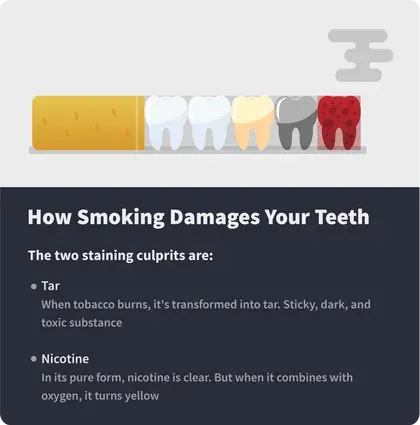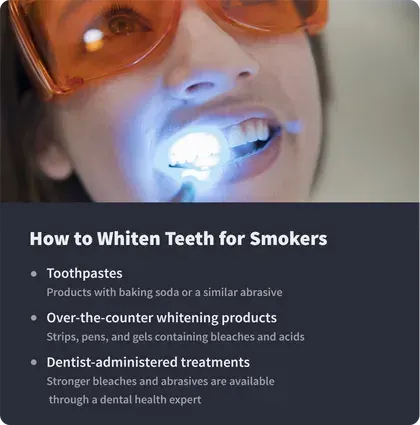Teeth Whitening for Smokers: Removing Stains
Table of Contents
- Smoking Causes Stains
- Repairing the Damage
- Other Dental Issues with Smoking
- Quitting Smoking
- Taking the First Step
- References
Tar and nicotine embedded within smoking products stain teeth. While the process is gradual, the color changes happen quicker than you might think.
More than 34 million American adults smoke, and they have the stained teeth to prove it.
If your teeth are stained from smoking, three methods can help you repair the damage. But remember that a smoking habit does more than cause cosmetic changes. Your health is at risk, and if you smoke, you should quit.
How Smoking Stains Your Teeth

Two key ingredients inside most smoking products can change the color of your teeth. Removing the harmful elements is impossible, as they are responsible for the character and the addictiveness of smoking.
The two staining culprits are:
Tar. When tobacco burns, it's transformed into tar. Sticky, dark, and toxic are all good words to describe this substance.
Nicotine. Cravings between puffs are common, and nicotine is responsible for them. In its pure form, nicotine is clear. But when it combines with oxygen, it turns yellow.
As you pull smoke in through your mouth, it passes by your teeth on the way to your lungs. You expel the same smoke on your exhale, which puts chemicals in contact with your smile once more.
Changes aren't immediate. You won't have a bright smile one day and dark the next. But each time you light up, you're adding to the damage done to your teeth. Your smile may look brown after years of smoking. The more cigarettes you smoke each day, the greater the staining.
Main Ways to Repair Damage

Tar and nicotine change the color of your teeth, but the damage isn't permanent. Treatments can remove the problem and restore your smile to a color you'd prefer.
Three methods you could use for teeth whitening include:
Products containing baking soda or a similar abrasive can scrape away some surface stains and reveal healthier tooth tissue.
Strips, pens, and gels containing bleaches and acids are available at most grocery stores and pharmacies. The products promise to lighten your teeth and remove stains that sit on the surface.
They've been proven effective in lightening the teeth of smokers. But if your smile is very discolored, you may need professional-grade help.
Stronger bleaches and abrasives are available through a dental health expert. You may need several appointments to lighten your teeth to a color you'd prefer, but the work is supervised by someone who can ensure you're not causing more damage with each visit. Stain removal stays stable, researchers say, when professionals get involved.
At-home, over-the-counter products range in price from about $10 to more than $100. But they're not guaranteed. You may not get the results you want, even if you follow the instructions carefully.
Work with a professional, and you can expect to pay hundreds to whiten your smile. It’s more expensive, but the results are much more dramatic. If you’re not satisfied with the results, you may be able to work with the doctor on a discount on additional treatments.
The smoke you pull into your lungs passes by your teeth first and each puff leaves stains behind, and they're too stubborn to remove with simple paste.
Other Ways Smoking Hurts Your Teeth
A yellow-brown smile is easy to see. But it's not the only problem smoking can cause. Each time you take a puff, you could cause harm that makes your smile even less appealing.
Smoking has been linked to:
Gum disease. Smoking weakens your immune system, and that makes oral infections more likely. Tissues in your mouth may swell, bleed, or hurt. And the longer you smoke, the greater your risk.
Cancer. Smoking is a main cause of mouth cancer. Tumors can form in the soft tissues of your cheek, on your tongue, or on the roof of your mouth. They may not hurt, but they can grow and make talking or eating difficult.
Tooth loss. Gums weakened by disease, infection, or cancer are less capable of holding teeth in place. Lose one, and neighbors can shift to fill the gap.
Some of these issues are treatable, but they are all very serious. If you're a regular smoker and you haven't considered quitting, now is the time to do so.
You Can Quit Smoking
More than half of all people who have ever smoked have also kicked the habit. You could do the same.
Leaving smoking behind cold turkey is difficult, as nicotine is very addictive. Your brain will continue to call out for the substance, even when you know it's not good for your body. But you can make the change with:
New habits. Try tossing a ball between your hands when you're tempted to light up. Or go for a quick walk around the block with your dog to shift your focus. If you find you're always tempted to smoke after meals, try some other activities to keep your hands busy.
Support. Ask your local hospital about support groups to help you quit smoking. Or reach out to your current smoker friends and tell them about your resolution. They might be willing to quit with you.
Medications. Ask your doctor about nicotine replacement patches, gums, and mints. Find out what type you should use and how to do so safely.
If you are considering quitting, skip the tooth whitening until you've successfully eliminated your habit. Research says your stains will come right back if you keep returning to smoking. But if you quit for good, you could see a difference that lasts.
Taking the First Step
It is encouraged that customers stop smoking before they start using teeth aligners. Leftover nicotine and tar in your mouth can stain the trays and make them visible when you talk or smile. Smoking can also weaken your mouth's overall health, and that makes moving teeth a bit riskier.
